Trapped Versus Eaten
Do Barn Owl pellets reflect mammal trap catches?
For the last few years we have been trapping small mammals during late summer on FBOG Reserves in order to determine what occurs where. This is for several reasons: not only because we’re fascinated by small furry animals, but also because they’re a valuable indicator of the health of the reserves – from a more cynical viewpoint they are food, especially for the Barn Owls nesting in the box at the Dams. In addition, some observers really like the view of freshly drawn human blood as an irate Field Vole takes its revenge after being in a trap overnight.
Over three weekends during September 2012, we set 50 Longworth traps stuffed with hay bedding, grain and pupae on both Friday and Saturday night and checked them the following morning to see what we had caught. Each weekend we focussed on a particular FBOG site, namely the Tip (TIP), Filey Dams/East Lea (DAMS) and Country Park/Rocket Pole (RPF) field. A summary of the results of the mammals found is presented in Table 1.
Table 1. Summary of the total number of small mammals trapped at each site in Filey during September 2012.
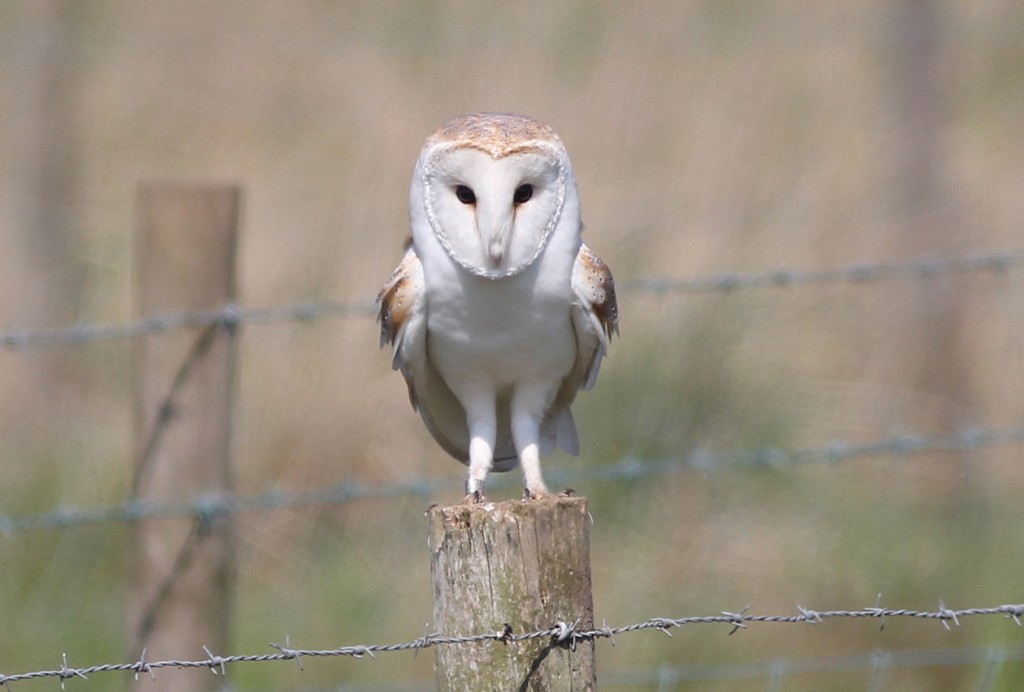
The male Barn Owl which breeds at the Dams.
| Common Name | Scientific Name | TIP | RTF | DAMS |
|---|---|---|---|---|
| Bank Vole | Myodes glareolus | 23 | 53 | 19 |
| Field Vole | Microtus agrestis | 0 | 13 | 24 |
| Wood mouse | Apodemus sylvaticus | 8 | 1 | 27 |
| Common Shrew | Sorex araneus | 5 | 15 | 4 |
| Pygmy Shrew | Sorex minutus | 1 | 0 | 0 |
| Water Shrew | Neomys fodiens | 0 | 0 | 13 |
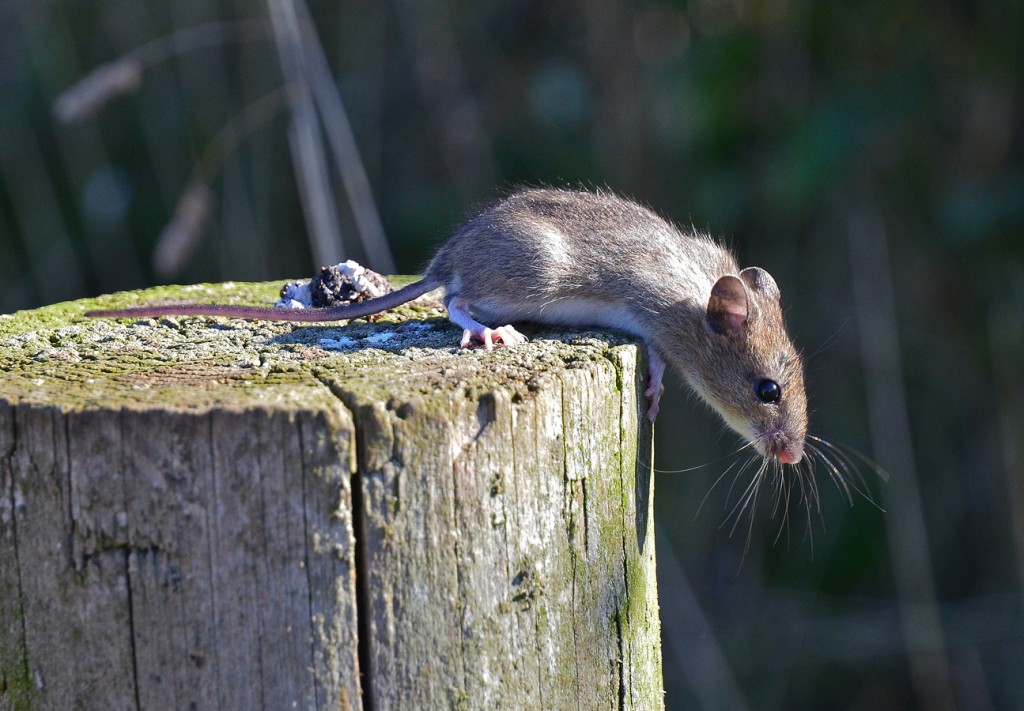
Wood Mouse at the Dams
A total of 196 small mammals of 6 different species were trapped from the three sites. The TIP had the lowest catch rate with only 37 individuals caught, most of which were Bank Voles. Bank Voles were also the commonest species at the RPF trap; they were however outnumbered by Field Voles at the Dams site. Wood Mouse was the commonest species at the DAMS (Table 1). Not many shrews were caught on the TIP or at the DAMS but Common Shrew was the second most abundant animal on the RPF, whilst Pygmy Shrew was only trapped on the TIP and Water Shrew only at the DAMS.
In conjunction with the live (humane!) trapping we also got our hands on over 100 Barn owl pellets from the box at Filey Dams during October 2012.This was not a dawn raid, but they were kindly collected for us by the ringers when they ringed the Barn owl chicks that summer. This presented an ideal opportunity to compare the live mammal results with those eaten by the Barn owls. As the Barn Owls not only hunt at the Dams but cross the main road to hunt we decided to compare the owl pellet findings with the counts of mammals caught in the Longworth traps as these indicated the abundance of the small mammals in the area.
We analysed a total of 97 pellets (some were discarded as they were so badly rotted (and fragrant!), carefully teasing the mass apart to extract the skulls and jaws. We then identified the jaws and skulls using a key based on the dentition and counted the number of skulls, left and right jaws separately to try and estimated the maximum number of individuals of each species. However we did ignore the maggots that were rampant in some pellets (even those that tried to escape across the table). A summary of the results is presented in Table 2.
Table 2. Summary of the total number of small mammal skulls and jaws found in Barn owl pellets. Numbers highlighted in bold represent the maximum number of individuals of each species found.
| Common Name | Scientific Name | Skull | Left Jaw | Right Jaw |
|---|---|---|---|---|
| Bank Vole | Myodes glareolus | 26 | 25 | 33 |
| Field Vole | Microtus agrestis | 157 | 156 | 162 |
| Wood mouse | Apodemus sylvaticus | 27 | 42 | 39 |
| Common Shrew | Sorex araneus | 56 | 28 | 38 |
| Pygmy Shrew | Sorex minutus | 6 | 3 | 3 |
| Water Shrew | Neomys fodiens | 8 | 9 | 11 |
| House Mouse | Mus domesticus | 1 | 3 | 2 |
| Harvest Mouse | Micromys minutus | 3 | 3 | 3 |
| Brown Rat | Rattus norvegicus | 0 | 1 | 1 |
| Sparrow | Passer sp. | 2 | 0 | 0 |
A total of 319 individuals of 10 different species were recovered from the owl pellets, with Field Vole by far being the most numerous. Bank Vole, Common Shrew and Wood Mouse were almost equally represented, but the real surprise was the two sparrow skulls found in the pellets (Table 2). Some mammal species occurred in the pellets but not in the Longworth traps. Whilst we have caught the illusive Harvest Mouse and House Mouse very occasionally in previous years, they were not trapped in 2012, but the Barn owls obviously found them. A small Brown Rat was also eaten by the owls.
Figure 1. The percentage occurrence of live mammals in Longworth traps compared to the percentage occurrence of mammals in owl pellets.
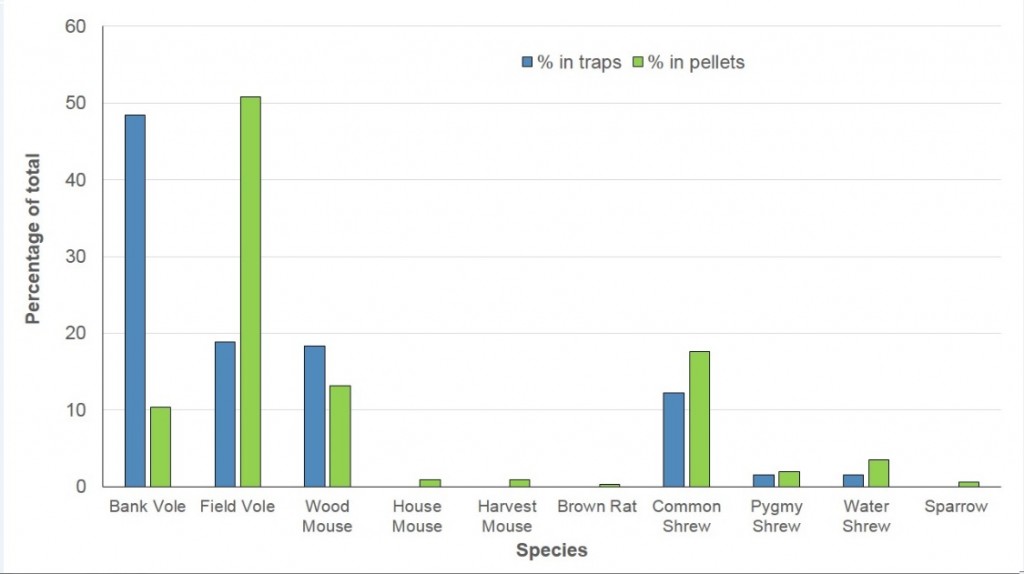
Bank Voles were the most numerous in terms of percentage of mammals caught in the Longworth traps but not the most numerous in the pellets (Figure 1). Field Voles are notorious for avoiding mammal traps, but they were the most abundant species in the Barn owl pellets – so the owls can obviously find them even if we struggle to trap them.
Harvest Mouse, House Mouse and Pygmy Shrew are rarely trapped, and the Barn owls also seem to rarely predate them, suggesting that these species are not common in the area or very difficult to locate. Whilst voles accounted for most of the mammals taken by the owls, Common Shrew and Wood Mouse appeared to supplement the owl diet.
A previous analysis of owl pellets from the Dams in 2005 showed a similar pattern, with Field Voles being the predominant prey items, and Wood Mouse and Common Shrew additional items. Surprisingly, the 2005 study also found an amphibian and a large bird (not identified) in the pellets. How the owls caught the sparrows in the current study we will never know, but they were a surprise in the pellets.
Field Voles can account for up to 80% of a Barn Owl’s diet, but other species uncommonly taken include bats, amphibians and small birds (according to the Barn Owl Trust, 2012). The same studies estimate that a breeding Barn Owl pair will need to catch up to 4000 small mammals over 70 days to raise an average brood of 3.5 chicks. Small mammals are also taken by other predators, and it is their population cycles that regulate the predator densities.
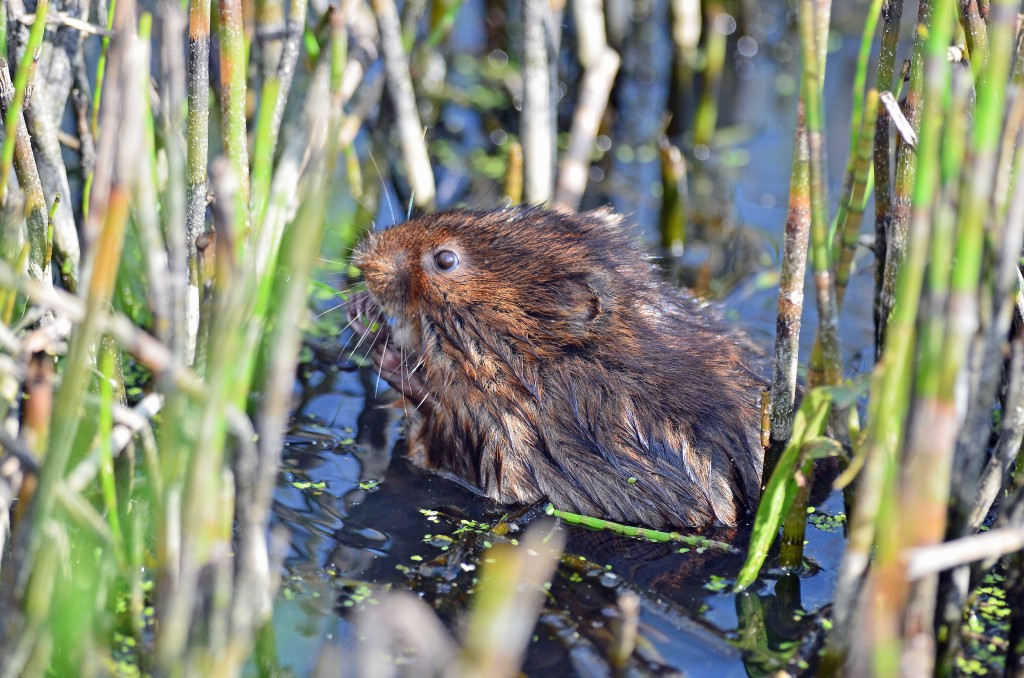
Water Vole at the Dams
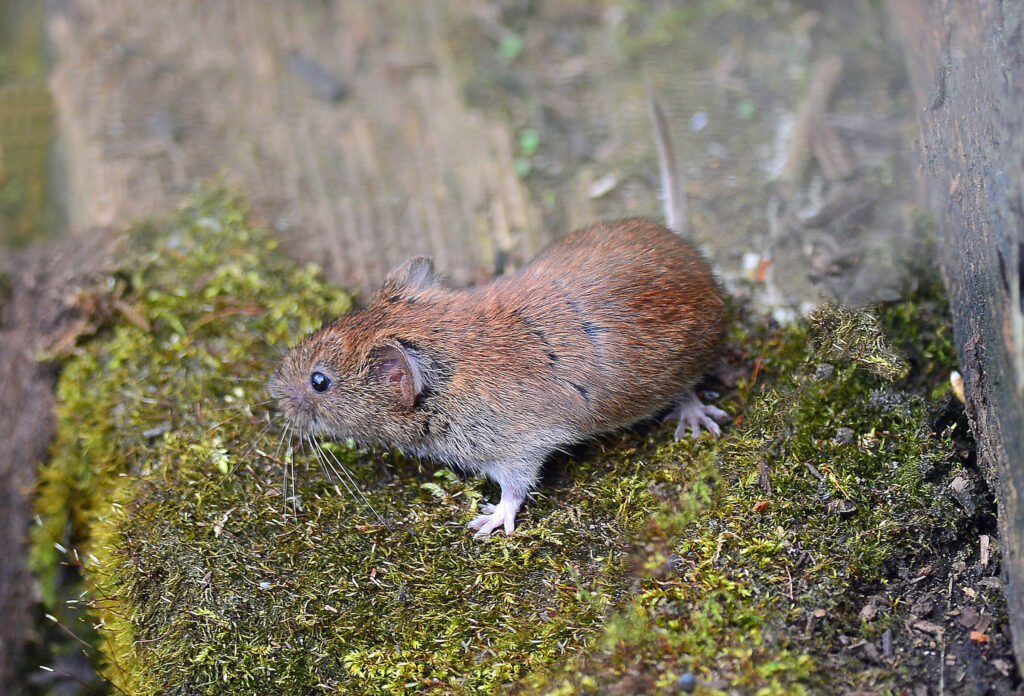
Bank Vole at the Dams
Over 5 years of mammal trapping, Field Vole has never been very common during trapping sessions; 2012 was a good year for this species (we actually caught some) and in contrast to other studies, this species only accounted for 50% of the mammals in the pellets. It might be that the Field Vole populations are quite low in the area due to the lack of large areas of suitable habitat, so the owls have to prey on other species.
Alternatively, the owls perhaps catch the first thing they come across rather than actively selecting their favourite prey from the mammal menu to meet the demands of hungry owlets, or they have quite catholic dietary tastes. One thing is clear though, coupling owl pellet analysis alongside the Longworth trap counts provides some very interesting information on the small mammal populations in Filey and further analysis of pellets may supplement the information from small mammal trapping.
By Sue Hull & Jack Whitehead
References:
- The Barn Owl Trust (2012). Barn owl pellets, diet and predators prey relationships. http://www.barnowltrust.org.uk.
- Whitehead, J. (2005) Mammal Society National Owl Pellet Survey. Imprint, No. 32, Yorkshire Mammal Group.
